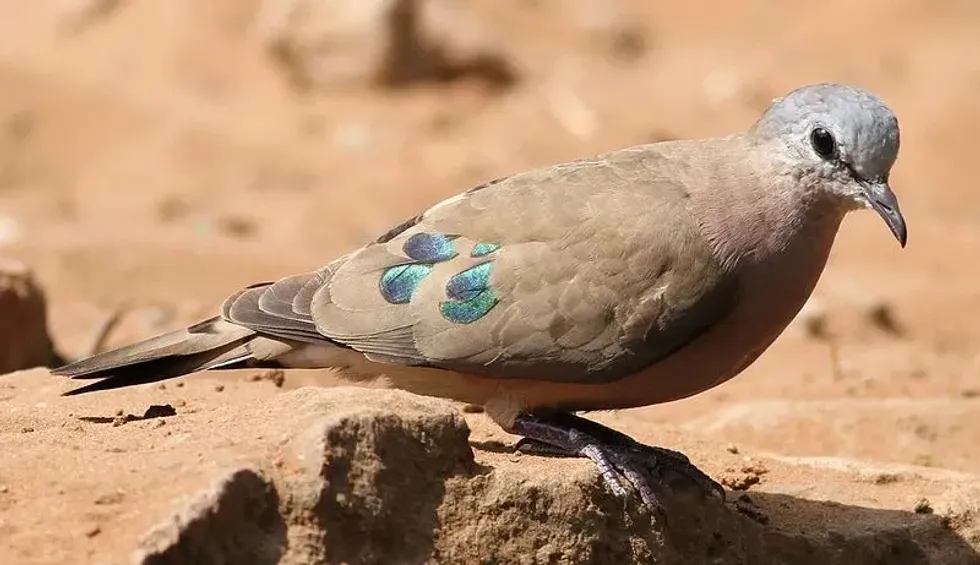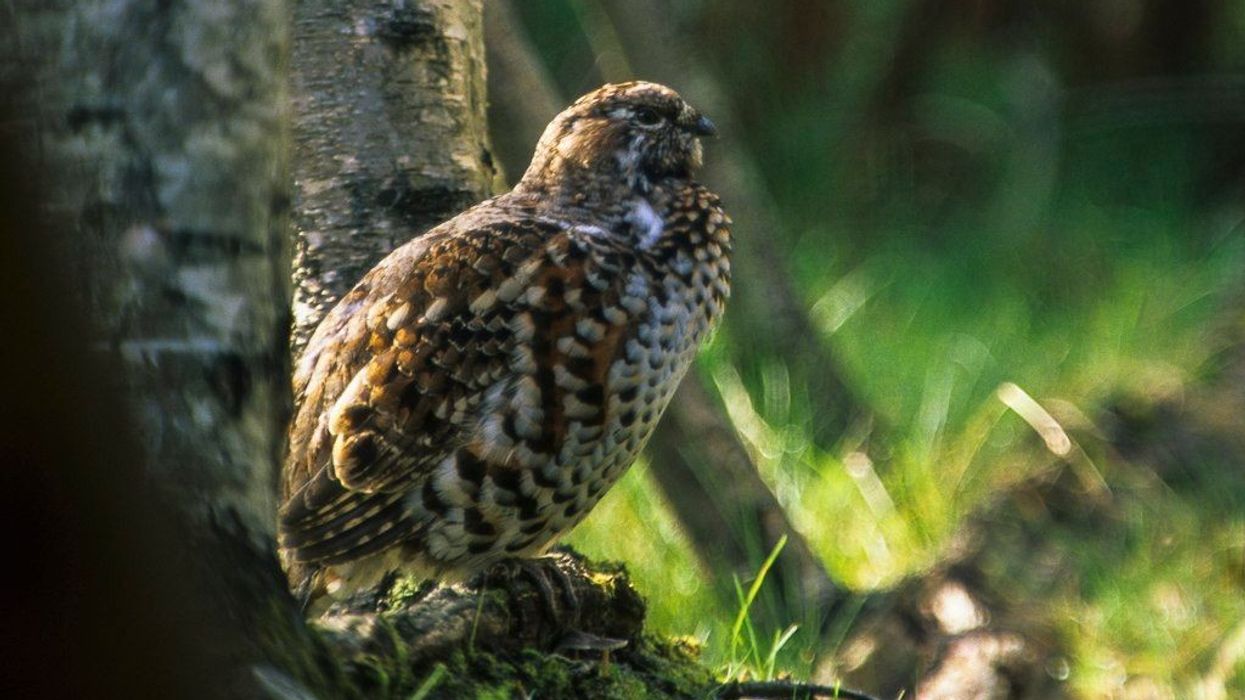First introduced by Pieter Boddaert, a Dutch naturalist, the genus Turtur is composed of five wood dove species that are endemic to sub-Saharan Africa. The word 'turtur' has Latin origins meaning 'turtle dove'.
Among the five species, the Turtur chalcospilos (emerald-spotted wood dove) is widespread in southern and eastern Africa. Historically, the species was divided into two: populations in western Africa were called Turtur chalcospilos volkmanni while these birds in eastern Africa were termed Turtur chalcospilos zambesiensis. Later they were classified together and considered monotypic.
These beautiful birds are famous for the glamorous iridescent green spots that add a metallic sheen to their plumage. Both sexes are brown colored with grayish-brown wings, a brown tail and pinkish underparts.
The bird can be found solely found in the African continent. These birds normally tend to stay away from semidesert regions and evergreen rainforests and, if you want to locate the emerald-spotted wood dove, South Africa might be the best place to go! Read on to know more about this intriguing species.
For more such enlightening information on other dove species peek into these illuminating facts about the barbary dove and brown dove.
Emerald-Spotted Wood Dove Interesting Facts
What type of animal is an emerald-spotted wood dove?
Grouped under the Columbidae family, the emerald-spotted wood dove (Turtur chalcospilos) is a species of bird.
What class of animal does an emerald-spotted wood dove belong to?
This dove species belongs to the Aves class and the Turtur genus.
How many emerald-spotted wood doves are there in the world?
The number of mature individuals in current existence is not known with certainty. However, the species is abundant within their habitat range, with a stable population trajectory.
Where does an emerald-spotted wood dove live?
Endemic to Africa, the species inhabits places like northwestern Somalia, South Sudan, and southern Ethiopia. Their population is evenly distributed through South Africa. They're alsovery common in Angola, coastal Gabon, northern Botswana, northern Namibia, Mafia and Zanzibar islands, the Republic of Congo, and adjoining places.
What is an emerald-spotted wood dove's habitat?
These birds can be frequently located in savannas, coastal forests, grasslands, open agricultural lands, and deciduous woodlands. Areas covered with dense shrubs and bushes are their favorite foraging spots.
Who do emerald-spotted wood doves live with?
These birds are not very sociable as they do not flock together. They've either been spotted dwelling alone, in pairs, or in small groups of three to four.
How long does an emerald-spotted wood dove live?
Spotted doves have a life expectancy of eight to nine years in the wild. However, the lifespan is variable depending upon the species' habitat and the specific threats they may face.
How do they reproduce?
Detailed information on the breeding behavior of this species is lacking. However, these birds are known to be monogamous. Males produce mating calls during the breeding season to please their partners and nests are usually constructed in a bush, stump, or tree at 20-197 in (0.5–5 m) above the ground.
Nesting materials include rootlets, grass, and twigs. The incubation period continues for 13-17 days and the clutch comprises two eggs. Both parents engage in parental care by feeding the chicks.
What is their conservation status?
The emerald-spotted wood dove (Turtur chalcospilos) of Africa has been classified as a species of Least Concern by the International Union for Conservation of Nature (IUCN) Red List.
Emerald-Spotted Wood Dove Fun Facts
What do emerald-spotted wood doves look like?
This bird is found in a dull brown color with a plump body. Both male and female birds exhibit similarities in appearance.
The head is mostly dull gray while the hindneck, underparts, wings, and tail are grayish-brown, turning pinkish near the breast. Iridescent green marks on the wings allow identification of the species and black streaks are also visible on the tail and lower back of the bird.
How cute are they?
With their small plump bodies, these chubby birds are nothing less than adorable.
How do they communicate?
Long, mournful songs are characteristic of all wood doves, due to which differentiating between them can prove to be quite challenging. The typical emerald-spotted wood dove sound renders helps with the identification of the species.
Cooing and whistling sounds are also common among wood doves. Their calls include flight calls, alarm calls, and advertisement calls. Apart from these calls and songs, these birds also interact through gestures like clapping their wings.
How big is an emerald-spotted wood dove?
The emerald-spotted wood dove (Turtur chalcospilos) is a medium-sized bird measuring around 7.5-8 in (19-20.3 cm) in length. The bird is comparatively larger than the common ground dove, ranging from 5.9-7.1 in (15-18 cm).
How fast can an emerald-spotted wood dove move?
Most doves fly at an average speed of 25 mph (40.2 kph) and quick movements have been recognized within the species. This bird tends to fly at low heights with an upper elevation limit of 6,562 ft (2,000 m).
How much does an emerald-spotted wood dove weigh?
An average emerald-spotted wood dove weighs about 2.3 oz (65.2 g).
What are their male and female names of the species?
Males and females are regarded as 'cocks' and 'hens' respectively.
What would you call a baby emerald-spotted wood dove?
A baby emerald-spotted wood dove is called a chick, hatchling, or nestling.
What do they eat?
This bird species feeds primarily on seeds, grasses, and herbs. Food is commonly extracted from hay, bulrush millet, guinea grass, chickweed, blue panic grass, and rescue grass. The diet seldom includes invertebrates like termites and mollusks.
Are they dangerous?
This species is absolutely harmless! When reared as pets, they might cause allergic reactions among some humans though. Otherwise, these shy birds prefer to remain close to the ground, hidden among bushes, and are generally safe to be around.
Would they make a good pet?
The emerald-spotted wood dove (Turtur chalcospilos) has the reputation of being a delightful pet. Despite their shy demeanor, these birds are known to be playful and eager to please. Occasionally, they might even fly down and feed on your hands.
Did you know...
The species is extremely common within its geographical boundaries. Its population trend is also stable with no potential threats. However, the species is vulnerable to predators like the shrike and the mongoose, who often hunt down these birds.
The emerald-spotted wood dove species is diurnal.
The emerald-spotted wood dove's call
Mating calls are the most prominent among these birds. Generally, males produce these low yet clear calls to attract females as well as to defend their territory.
These calls can be heard mainly during the breeding season in the early hours of the morning until the afternoon. An emerald-spotted wood dove call can be identified near nesting areas, even if the bird is completely concealed among the bushes! The call of a blue-headed wood dove has a comparatively lower pitch and is less prolonged.
Comparisons with other wood doves
Among the five species of African wood doves, the blue-headed wood dove (Turtur brehmeri) can be found most commonly in the rainforests of Africa, while the black-billed variation (Turtur abyssinicus) is abundant to the south of the African Sahara desert.
The blue-spotted wood dove (Turtur afer) is mainly found in the southern Sahel region, whereas the Tambourine dove (Turtur tympanistria) is found from Senegal, Ethiopia, and Kenya to south-eastern parts of South Africa.
The range of these birds overlaps to some extent, but the distinct metallic spots of bright iridescent green feathers separate emerald-spotted wood doves from the rest.
Here at Kidadl, we have carefully created lots of interesting family-friendly animal facts for everyone to discover! For more relatable content, check out these pheasant facts and stork facts for kids.
You can even occupy yourself at home by coloring in one of our free printable spotted dove coloring pages.










